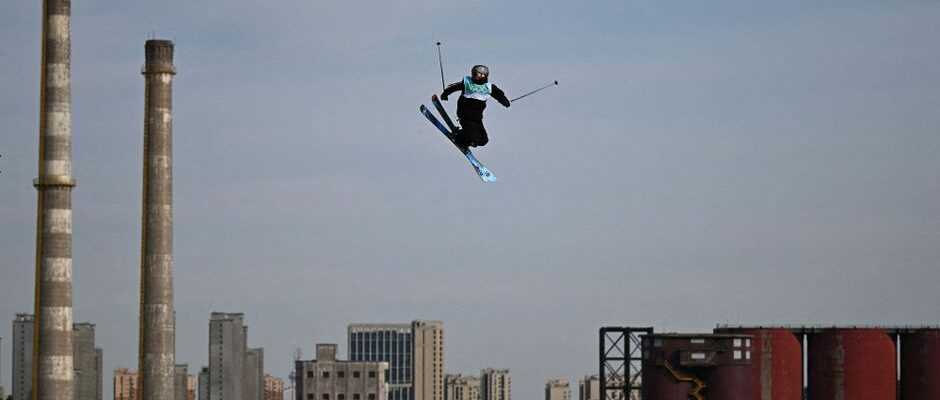A mountain of criticism is directed at the IOC and the organizers of the Beijing Winter Olympics who claim to have orchestrated “green” and “clean” Games.
A white ribbon winding through arid brush: the image of the alpine ski slopes of the 2022 Olympics captured from its flight to China by the Norwegian Kjetil Jansrud could sum up the environmental “aberration” denounced by experts. This is one of the strong commitments of the organizers of the 2022 Olympics (February 4-20): the Beijing Games will be “green” and “clean”, they insist, ensuring that the electricity consumed during the Olympic events will be entirely of renewable origin, “a first in history”, or that 85% of the vehicles used for the Olympic fortnight will run on electricity or hydrogen.
In Zhangjiakou, the city 180 km northwest of Beijing where Nordic skiing, biathlon, freestyle skiing and snowboarding events take place, forests of wind turbines can produce 14 million kilowatts per hour. The surrounding mountains are covered with solar panels with an additional capacity of seven million kilowatts / hour while 33,000 hectares of forest and vegetation (47,333 ha in Beijing) have been planted since 2014 to offset carbon emissions. When a preliminary report by the Organizing Committee was published in mid-January, the IOC stressed that “the principles of sustainability had been integrated into all stages of the preparation of the Olympic Games, to minimize the negative impacts of the Games and maximize positive effects”. But neither the IOC’s satisfaction nor the measures taken by the organizers reassure the experts interviewed by AFP.
“Irresponsible”
Worse: the superb Big Air event and its 60-meter springboard have been installed in the heart of the former Shougang industrial zone. The steelworks, which was once the country’s leading production site and the city’s largest employer with up to 65,000 workers, closed in 2010. “Organizing the Olympics in this region is an aberration, it’s irresponsible », regrets the geographer Carmen de Jong, from the University of Strasbourg, about the exclusive use of artificial snow and therefore a lot of water to snow Olympic competition sites located in an arid / semi-arid climate, in only 1,500 km southeast of the Gobi Desert. “We are in a region that is already experiencing a water shortage, that is the main problem,” she continues. “According to very conservative calculations, on the ten snow competition sites, at the rate of 10,000 m3 of snow per hectare, it would take about two million m3 of water.”
“We put the Winter Games where we shouldn’t have put the Winter Games,” adds Martin Müller, from the Institute of Geography and Sustainability at the University of Lausanne (Unil). “We are going to disturb the ecosystem, a large part of the infrastructure was missing”, continues the academic, who also deplores the absence of “transparency which would make it possible to evaluate these Games there compared to others in environmental matters”. Although he is careful not to present them from the outset as the most environmentally damaging Olympic Games in history, Martin Müller rejects the term “green Games”: “they will not be among the most sustainable Games ( …) the sustainability of the Games has been declining since the 2010s”, he recalls in reference to those of Sochi in 2014 and Pyeongchang in 2018, and even those of Vancouver in 2010.
French snowboarder Chloé Trespeuch, sensitive to environmental issues, also said she was “disappointed” with the choice of Beijing to host the Winter Olympics, disputed for the first time on 100% artificial snow. “I’m a little disappointed that they chose a place that is not necessarily suitable for practicing winter sports and that had to be transformed,” the snowboardcross specialist told a press conference. . “I hope that we all talk about it, that we realize that it does not necessarily suit us to have such a negative impact on nature and that the next events will have a greater concern for the planet”, she added.
In Qatar?
The example of Beijing with its climate, certainly lacking in precipitation and snow but with extremely low temperatures, could open a new era, notes Robert Steiger, from the University of Innsbruck. “In the future, the Games may only be awarded to cities with a very cold climate like Beijing, because even without natural snow, from the point of view of the conduct of competitions, there is no problem. in this type of climate” without sudden snowfalls or sudden warming of temperatures, explains the Austrian academic.
In a context of scarcity of candidate cities for the organization of the Winter Olympics – two for the 2022 Olympics, Beijing and Almaty – faced with the financial and environmental costs, particularly in Europe, we are “at a bifurcation”, recognizes Martin Müller.
To read :Beijing 2022, the best French chances of medals
“Do we accept the principle of only using artificial snow? It is a political question which would increase the number of candidate cities, but also a completely ethical and ecological question”, notes the professor from the University of Lausanne. “The next step is to say: we no longer need the mountains, we can build something artificial, in Qatar I don’t know, if we can air-condition football stadiums (for the World Cup-2022). Except for the descent where you need a vertical drop of 800 m, for the rest, it’s playable”, he worries.
Any reproduction prohibited
